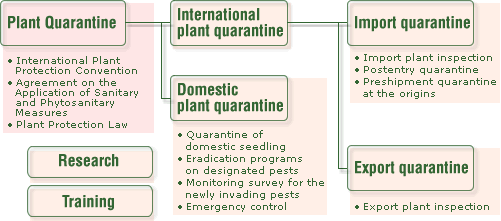 |

If plant pests and diseases (hereinafter referred to as pests) infiltrate into a virgin area, they often cause disastrous losses to crops and other agricultural resources. To mention a few among examples, the grape phylloxera was introduced from North America into Europe, thereby, triggering the enactment of plant quarantine laws and regulations. The Japanese beetle was brought from Japan into the United States and emerged as a devastating pest of many crops. In our seagirt country, the strict isolationism policy that was taken during the Edo era, virtually precluded the invasion of pests from abroad. During the following Meiji era, however, various pests such as the wooly apple aphid, arrowhead scale and crown gall entered into Japan and seriously threatened agricultural production. Consequently, the Plant Quarantine Law was promulgated in 1914. The ever increasing expansion of international trade has brought about an influx of wide varieties and tremendous amounts of agricultural products. Also, the development in modern transportation technology has enabled the movement of a great number of commodities within a short time, thereby, facilitating the transfer of fresh perishable products from one country to another. As a consequence, the risk of invasion of pests accompanying these products has become increasingly more serious.
The plant quarantine service aims at protecting Japanese agriculture from the infiltration of quarantine pests from abroad by means of import quarantines at seaports and airports throughout Japan. The service undertakes domestic quarantine to prevent the proliferation and spread of local pests which seriously threaten agricultural crops. It also conducts export quarantine to comply with the requirements from overseas countries.
|
 |

